Eucratoscelus
Genus Eucratoscelus POCOCK, 1898
Genus status. Considered monotypical untill the year 1990 when another one species has been established. Synonymy: Harpactira constricta (syn.n.) = Eucratoscelus longiceps (syn.n.) = Eucratoscelus constrictus; Pterinochilus spinifer (syn.n.) = Eucratoscelus constrictus; Eucratoscelus tenuitibialis (syn.n.) = Pterinochilus lugardi.
Type species – E. longiceps POCOCK, 1898 (= E. constrictus GERSTÄCKER, 1873), syn. name
The genus was established by Reginald I. POCOCK in 1898 on the basis of a female specimen from the locality Taveta in southern Kenya, close to the Tanzanian border, described as Eucratoscelus longiceps. In 1873 (25 years before the offical genus name) german arachnologist Dr. Carl GERSTÄCKER has described the species named Harpactira constricta, considered the syn. name of E. longiceps.
In 1990 germans Dr. Günther SCHMIDT and Volker VON WIRTH on the base of the female specimen described the second species - E. pachypus from the unkonwn locality; and in 2002 R. Gallon described the male of E. pachypus.
The last point for the modern taxonomy of the genus Eucratoscelus as well as of the whole Subfamily Harpactirinae was done by the same Britain arachnologist R. Gallon in 2002 (GALLON, R. C. 2002. Revision of the African genera Pterinochilus and Eucratoscelus (Araneae, Theraphosidae, Harpactirinae) with description of two new genera. Bull. Br. arachnol. Soc. 12 (5), 201–232). This paper not only described the male of E. pachypus but also synonymizes E. longiceps with the E. constrictus and established the key for the genus and species, listed below.
The genus Eucratoscelus can be differentiate to other Harpactirinae genera by the complex of the following characters (note-some characters maybe found in separate species from other harpactirine genera):
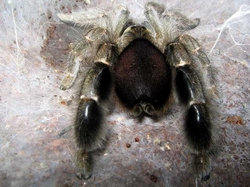
- strongly incrassate tibia IV (viewed dorsally); - scopulae on the chelicerae retrolateral present; scopulae on the chelicerae prolateral absent; - typical Harpactirinae abdominal pattern absent/weakly developed; - fovea transverse; - distal segment of posterior spinneret digitiform; - tarsal scopulae undivided; - metatarsal scopulae on leg I, II and III undivided; -metatarsal scopulae on leg IV bisected longitudinally by band of stiffened setae; spermathecae paired, with terminal lobs (see drawing).
In fact the only one species known in captivity - Eucratoscelus pachypus, which can be easily separated from all other African tarantulas by its distinctive long brushes of setae and incrassate “bushy” tibia of the rear legs. This gives it a wonderful feathered appearance which can’t be mixed with any other tarantula around the World fauna.
This small to medium sized tarantula (males around 25mm, females - 50 mm) widely presented in hobby and regularly seen in dealer’s stock, but not be fooled – all these are wild caught specimens. This tarantula is extremely hard to breed – in fact the only one case has been recorded and the appropriate description was published and two other known by the communication reports.
The type species (E. constrictus) claimed to be known in hobby over 10 years ago in small amount from the Kenian export but last time no any specimen entering the hobby. It is differs from E. pachypus in very few characters (only the rear legs are thickened; in E. pachypus – all the entire legs are robust), so further studies may consider them to be synonymous (?).
The keys to the species of the genus Eucratoscelus:
By females:
- Only tibia of leg IV incrassate - E. constrictus
- Tibia, metatarsus and tarsus of leg IV incrassate - E. pachypus

By males:
- Embolus strongly curved (viewed retrolaterally); carapace lengh/ocular tubercle with ratio c. 6.5 - E. constrictus
- Embolus slightly curved (viewed retrolaterally); carapace length/ocular tubercle with ratio c.5.5 - E. pachypus
Thus, only limited data has known about E. pachypus here I mention only the information regarding this particular species.
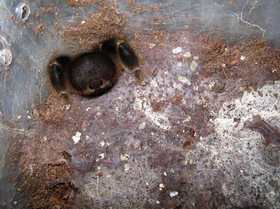 In nature this “baboon-spider” (as it called together with all other theraphosid spider representatives originated form Africa) inhabits open savannah, grassland and scrubland areas where lives in deep burrows, but indeed a very little known about it natural history and not enough study provided for the better knowledge. One interesting feature which noticed by many hobbyists used to kept that spiders (happened once in my case of keeping this spider for 2 years, after I put this page on-line ;)) is connected with its external anatomy. Representatives of the genus Eucratoscelus has enlargened (thickened) hind legs armored with the hard spins. Thus interesting display of this species has been noted - being in the retreat it blocks the entrance with its back and hind legs. The same observation for E. pachypus has been recorded in the wild.
In nature this “baboon-spider” (as it called together with all other theraphosid spider representatives originated form Africa) inhabits open savannah, grassland and scrubland areas where lives in deep burrows, but indeed a very little known about it natural history and not enough study provided for the better knowledge. One interesting feature which noticed by many hobbyists used to kept that spiders (happened once in my case of keeping this spider for 2 years, after I put this page on-line ;)) is connected with its external anatomy. Representatives of the genus Eucratoscelus has enlargened (thickened) hind legs armored with the hard spins. Thus interesting display of this species has been noted - being in the retreat it blocks the entrance with its back and hind legs. The same observation for E. pachypus has been recorded in the wild.
As most African representatives of theraphosids this is not a docile species but not as defensive as its relatives of the genus Pterinochilus and prefer to hide instead of attack the “adversary”.
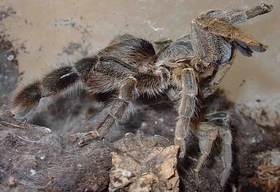 Another one fascinating feature of this species – the totally different appearance between the males and females, which even can be noticed 1-2 molts before ultimate molt (the last or maturity molt for most male tarantulas). This difference is not only the very distinct size of maturity of males (to half of the females) but also can be seen in less thickened (or un-thickened) legs IV (hind legs) as the most notable that large juvenile-subadult males has a distinct longitudinal band-formed stripe (it is more evident that at the same age female doesn’t have thickened legs).
Another one fascinating feature of this species – the totally different appearance between the males and females, which even can be noticed 1-2 molts before ultimate molt (the last or maturity molt for most male tarantulas). This difference is not only the very distinct size of maturity of males (to half of the females) but also can be seen in less thickened (or un-thickened) legs IV (hind legs) as the most notable that large juvenile-subadult males has a distinct longitudinal band-formed stripe (it is more evident that at the same age female doesn’t have thickened legs).
In captivity this fossorial species must be kept in very dry conditions with the thick layer of substratum given the possibility to excavate a burrow, which it usually lines with the big amount of web.The water bowl must be provided but it is not necessary if You keep moistening the part of the substrate around its hiding area. But bear in mind that You should maintain very good ventilation for this spider.Many people were unsuccessful keeping these spiders and claim on regular death of their specimens but if You try to deeply analyze most of such cases You’ll find that these spiders simply were kept too wet.
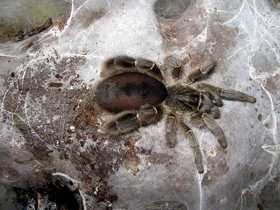 This is one another excellent example for rare case of tarantula which successful key for the care – absolute dry environment together with the lower temperatures. Another one species which should require very similar conditions is the South American bird-eating spider - Chromatopelma cyaneopubescens, unless this one is tolerant to rather higher temps.
This is one another excellent example for rare case of tarantula which successful key for the care – absolute dry environment together with the lower temperatures. Another one species which should require very similar conditions is the South American bird-eating spider - Chromatopelma cyaneopubescens, unless this one is tolerant to rather higher temps.
Sometimes these tarantulas do not eager to dig at all and You can help them to settle in a new enclosure just making a hole with Your finger in one of the corners of its terrarium.
As it told before the only one case has been described regarding the breeding success with this species. This tarantula has very distinct and unusual mating (courtship) behavior.
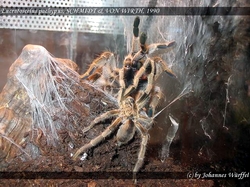
Here it is as described by Richard Gallon: “As he advanced towards the female he periodically clenched his two front legs whilst they were off the ground. The pair engaged, the male raising the female with his tibial spurs, in typical harpactirine fashion. After the mating was complete the male withdrew from the scene leaving the female in a raised ‘trance-like’ state.” (Gallon, R.C. 2004. Captive breeding Eucratoscelus pachypus. Journal of the British Tarantula Society 19(3): 78-81)
As provided by R. Gallon the breeding data are the following:
Mating occurred – July 4, 2003;
Eggsac made – September 17, 2003;
Nymphs II - November 22, 2003;
Spiderlings emerged - December 28, 2003.
Another breeding data (togeter with the photos) is kindly provided by great Canadian arachnoculturalist Martin "Tarcan" Gamache:
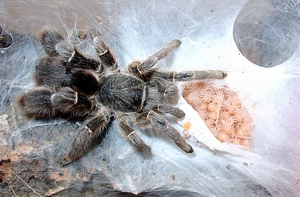
Female mated on 22nd of June 2005
Eggsac found on 23rd of October 2005
Eggsac taken out on the 26th of November 2005
In this case the amount of slings in the eggsac numbered are 118.
Follows to add to the info provided that as it seen on a picture Eucratoscelus spp. are known as much the most other Harpactirine representatives to built so-called fixed type of the eggsac, unlike most of the Americas Theraphosinae.
Distribution. Both species of the genus Eucratoscelus are known only from the neightboring territories of Kenya (E. constrictus) and Tanzania.
|
Species |
Common name |
Areal |
Foto |
Biology, status |
Keeping conditions |
|
constrictus |
- |
Kenya |
- |
Any biologic data is absent |
Unknown in captivity |
|
pachypus Schmidt & von Wirth, 1990 |
Tanzanian Stout-Leg Baboon |
Tanzania, poss. Kenya |
Photo (c) Photo (c) |
As it is described for the genus above |
As it is described for the genus above |


